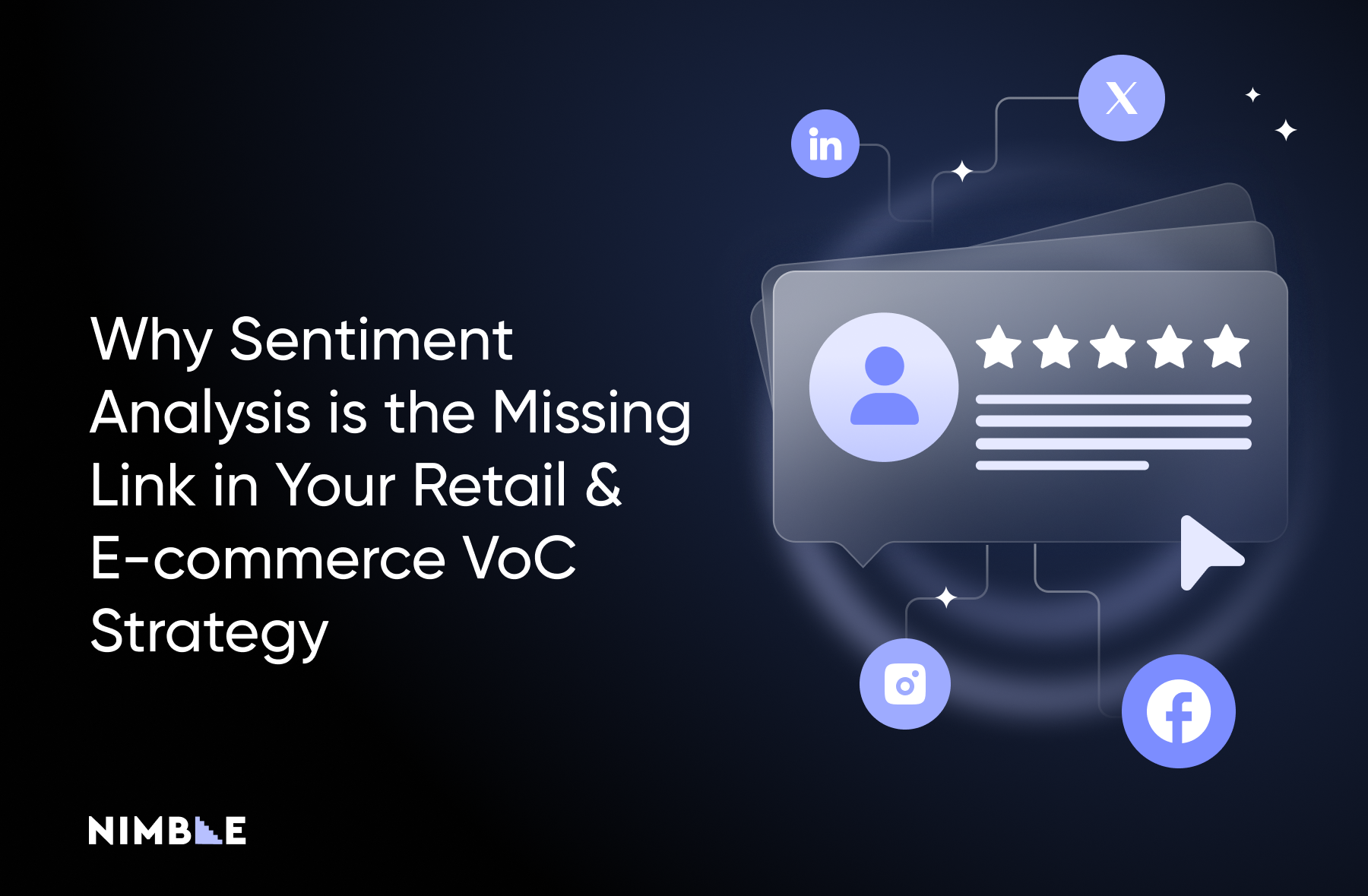A Comprehensive Guide to Data Parsing: What It Is and Why It Matters
Learn how to parse raw web data and transform it into a format that can be used in data analytics, web development, and more.


In today’s data-driven world , understanding data parsing is essential. Data parsing simplifies the conversion of complex data into usable formats, playing a pivotal role in everything from software development to business intelligence. This guide breaks down the essentials of data parsing, offering a practical overview that will benefit developers, business analysts, and data enthusiasts alike. From its applications in web scraping to its role in modern data workflows, this guide will help you navigate the process of data structuring/parsing.
What is Data Parsing?
Data parsing is the process of converting raw data from its unstructured, original format into a more structured and readable format that makes it easier to analyze and use. It can also refer to the general process of converting data from one format to another.
Data parsing is crucial because raw data comes in many shapes and sizes, and is often delivered in large, messy, and hard-to-manage collections. For the data to become useful and meaningful across different applications, it needs to be reformatted so it can be read and analyzed by people, machines, and applications.
Therefore, parsing is an absolutely essential step of the data handling process for anyone that wants to use data in any capacity, whether that’s for conducting analyses, teaching machine learning, or fueling automated algorithms.
Common Data Formats
Raw data can theoretically take any form—text files, a collection of images, or a table. However, if you’re gathering data directly from a web scraping API or a database, it will generally be delivered in one of the following formats. Structured, parsed data will always take on one of these formats.
XML (eXtensible Markup Language)
XML is a highly structured format with well-defined tags and elements. It is ideal for managing complex data that involves hierarchical relationships.
JSON (JavaScript Object Notation)
JSON is a lightweight, text-based format that is both human-readable and machine-parsable. It is widely used in web applications for its simplicity and ease of use.
CSV (Comma-Separated Values)
CSV is a straightforward format where data is separated by commas. This simplicity makes it a popular choice for representing spreadsheet data.
Nimble Expert Tip: Ask yourself– Does your project demand hierarchical XML or simple CSV? Knowing which format your parsed data needs to be can massively influence how you’ll parse it, and will help you to determine the tools to use.
Types of Data Parsers: Choosing the Right One for Your Needs
There are various types of parsers serving unique roles, especially in areas like web scraping and data analysis. Understanding the different types of parsers is important. Each type of parser offers unique functionalities, making them suitable for various applications, from simple web scraping tools to complex data analysis. Selecting the right type can make your data extraction more efficient and effective.
Tree-based Parsers
These are particularly useful in web scraping where complex, hierarchical data, like XML, is involved. They create a tree-like structure of the data, allowing for efficient navigation and extraction of information, which is essential in a web scraping tool that deals with deeply nested data.
Event-driven Parsers
Often used in web scraping scenarios involving large data files, these parsers respond to specific elements in the data. Their efficiency in processing streams of data makes them ideal for web scraping tools designed for real-time data extraction.
Regular Expression Parsers
For simpler tasks in web scraping, where quick text-based data extraction is needed, regular expression parsers are the go-to. They use pattern-matching techniques to swiftly identify and extract relevant data, a common requirement in web scraping tools.
Nimble Expert Tip: Tree-based parsers are typically more powerful but also slow, while regular expression parsers are quick and lack the same flexibility as tree-based parsers. You’ll want to choose parsers based on your data's complexity.
Data Parsing in Use: Web Development, Analysis, and More
Parsers play a significant role in various applications across web development, data analysis, and even software configuration. Here’s an example of each:
Web Development
Use Case: In web development, parsers, especially those handling JSON data, are indispensable. They are a key component in web scraping tools used in languages like JavaScript, enabling seamless integration and manipulation of data from web APIs.
Data Analysis
Use Case: In data analysis, languages such as Python utilize parsers to read and analyze CSV data. This is vital in scientific and financial applications, where accurate data parsing directly impacts the analysis outcome. Parsers in these applications often resemble sophisticated web scraping tools, extracting and processing large volumes of data.
Configuration Files
Use Case: XML parsers, crucial in software development, are extensively used for reading configuration files. These files are integral to the functionality of many applications, including web scraping tools, dictating crucial operational parameters.
Through the transformation of raw data into structured, interpretable formats, parsers are central to enhancing the capabilities of any data collection project. They not only facilitate informed decision-making and process automation but also drive innovation in data-driven industries.
“Using Nimble supercharged our data-gathering capabilities, delivering clean, real-time web data we could immediately put to work". — Tom Zakheym, VP Talent Acquisition, TheVets
The Business Perspective: Building vs. Buying Your Data Parsing Tool
This approach involves developing a customized solution tailored to the specific needs and requirements of the organization.
Building an In-House Data Parser
Creating a data parser in-house is a significant decision for any business venturing into the complex realm of data processing. This approach involves developing a customized solution tailored to the specific needs and requirements of the organization. Here, we explore the pros and cons of such an endeavor, along with some illustrative examples to provide real-world context.
Pros:
Complete Customization for Specific Needs
Developing a parser specifically for your business needs can offer unmatched flexibility, ensuring greater efficiency in handling unique data processing tasks. This bespoke approach can be particularly beneficial in industries with specialized data formats or unique processing requirements.
Full Control Over Integration and Updates
Having complete control over the development process allows for seamless integration with existing systems and enables adjustments to be made swiftly as per changing needs.
Long-Term Cost Savings for Ongoing Projects
An initial investment in building a custom parser can lead to long-term savings, especially if your data processing requirements are ongoing and subject to change. This can be particularly cost-effective for businesses with a steady need for data manipulation.
Cons:
Resource-Intensive (requires time and expertise)
The need for significant resources — in terms of time, technical expertise, and finances — can pose a challenge, especially for smaller businesses or startups without a dedicated development team.
Ongoing Maintenance
An in-house parser requires ongoing maintenance and updates to stay in line with the latest data processing standards, adding to the operational workload.
Risk of Obsolescence Without Continuous Updates
In-house solutions may become outdated if they are not continuously improved and adapted to the latest technological advancements.
Buying a Commercial Data Parsing Tool
Opting for a commercial data parsing tool is an alternative route for businesses looking to streamline their data processing operations.
Pros:
Ready-to-Use with Minimal Setup
Commercial data parsing tools are generally designed for immediate deployment. Their plug-and-play nature means minimal setup time, making them an ideal choice for businesses needing quick solutions for data processing tasks.
Regular Updates and Professional Support
One significant advantage of commercial tools is the inclusion of professional support and regular updates. These tools are maintained by their providers to stay abreast of the latest data standards and processing technologies, offering peace of mind and reliability.
Frees Up Internal Resources for Other Tasks
By opting for a commercial tool, businesses can alleviate the burden of technical maintenance and troubleshooting. This allows them to focus more on core business activities rather than on the intricacies of data parsing tool upkeep.
Cons:
Less Flexibility Compared to Custom-Built Parsing Solutions
Commercial tools are designed to cater to a broad range of data processing needs, offering a balance of convenience and functionality. While they may not provide the same level of detailed customization as in-house solutions, many commercial tools offer considerable adaptability and can be configured to meet a variety of specific requirements.
Subscription or Licensing Costs
Commercial data parsing tools usually require subscription fees or licensing costs. Yet, these expenses are often balanced by their value, offering high reliability, consistent updates, and professional support. For many businesses, the time saved and efficiency gained from these tools make them a cost-effective long-term solution.
Here at Nimble, we are doing everything we can to minimize the potential cons. Our web scraping APIs are constantly updated and optimized to offer the best of both worlds at the highest level of flexibility and quality. Our tools are customizable to meet your specific needs while providing top-notch support and regular updates.
Technologies for Data Parsing: Popular Tools and Their Uses
If you decide to build your own parser, selecting the right technology is crucial. Here’s a breakdown of the most popular tools used in data parsing.

Nimble Expert Tip: If you're working with dynamic web pages, tools like Selenium or Puppeteer are your best bet.
How to Choose the Right Tool
- Data Types: The format of data you need (HTML, XML, etc.) greatly influences your choice of tool. For instance, BeautifulSoup is excellent for simple HTML parsing, while LXML offers high performance for more complex tasks.
- Performance Needs: If you're working with large datasets, a tool like LXML might be more suitable due to its high performance. On the other hand, for dynamic web pages where interaction is needed, Selenium or Puppeteer would be more appropriate.
- Ease of Use: For those new to data parsing, user-friendly tools like BeautifulSoup offer a shorter learning curve, making them an ideal starting point.
In summary, the choice of data parsing tool depends on the specific requirements of your project, such as the complexity of the data, performance needs, and your own expertise in data parsing.
Nimble’s Web Data-Gathering Solutions for Businesses
At Nimble, we specialize in streamlined web data-gathering solutions tailored to your diverse business needs. Our web API is designed for maximum scalability and performance, making sure that you get high-quality, structured data with minimal effort.
Key Features of Nimble's Web Scraper:
Smooth Data Collection
Our web scraper is built to efficiently navigate and extract data from a range of websites, delivering high-quality results.
Advanced Parsing Capabilities
We employ sophisticated parsing techniques to convert web data into structured, usable formats. This ensures that the data you receive is not only accurate but also immediately actionable.
Scalability
Our tool is designed to handle data collection tasks of any size, from small-scale projects to large-scale operations, without compromising on performance or accuracy.
Integrated Proxies
Bypass geo-restrictions and IP blocks for uninterrupted web scraping: Nimble's APIs are integrated with a modern residential proxy network, enabling it to bypass common web scraping barriers such as geo-restrictions and IP blocks.
Final Words
Understanding and implementing effective data parsing techniques is crucial for any data-driven business. Whether you choose to build your own parser or leverage commercial tools like those offered by Nimble, having the right parsing strategy in place can unlock powerful insights, streamline operations, and drive innovation. This comprehensive guide explores data parsing, from basic principles to sophisticated tools to custom data parsing tools for businesses.
Are you ready to optimize your data processes? Start a free trial with our Web API or contact us to get more customized solutions.
FAQ
Answers to frequently asked questions

















